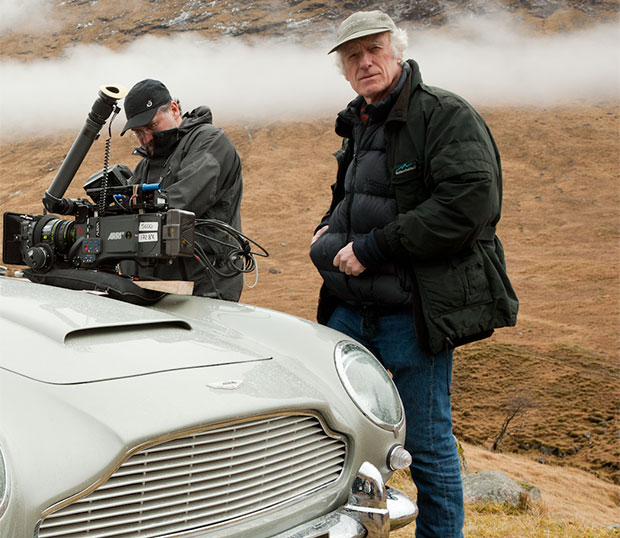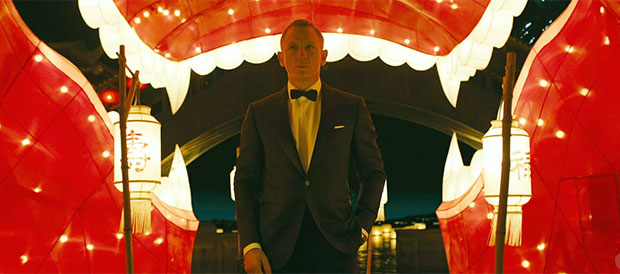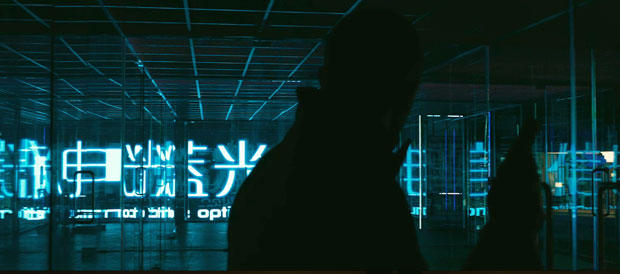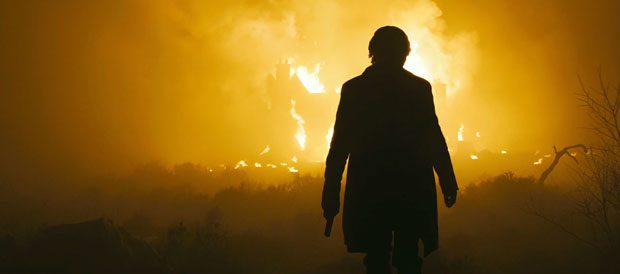
This article contains minor spoilers for Skyfall.
A cinematographer’s job may be to bring the visuals of a film to life through lighting and camera movement, but for Roger Deakins it’s rarely about finding “the right look.” Hisunique philosophy to shooting feature films — less photographer than interpreter of words — may be the reason why Deakins’ career includes some of the best dramas of the last 20 years. It also makes him a unique pick to shoot the latest James Bond blockbuster, Skyfall.
“I’m not an obvious choice to do an action movie,” says Deakins. “That’s not what I’ve been doing.” Beginning his career in documentary, Deakins transitioned to feature films like 1984 and Sid and Nancy. In the ’90s he found his most lucrative collaborators, the Coen Brothers, for whom he shot Barton Fink, Fargo, O Brother, Where Art Thou?, No Country for Old Men and more. “I don’t see images when I read a script. I see characters. I’m interested in character development. The arc of the story.”
After teaming with director Sam Mendes on 2005’s Jarhead and 2009’s Revolutionary Road, Deakins was enlisted by the theater-director-turned-filmmaker to man the camera to take on duties for Skyfall. “Sam came to L.A. one time, we went for a walk on the beach, and he basically talked to me about the script, his thoughts on what he thought he could do with the franchise,” says Deakins. Surprisingly, Mendes’ hope was to maintain the style they he and Deakins honed on their previous, smaller scale dramas. “There’s a danger when you do action movies, they all end up looking the same. End up being coverage. People do great stunts… big budget movies are trying to one up each other, move the camera in a more audacious kind of way. But that’s not where we came from at all.”

Deakins grew up watching Bond, but his goal was never to pay homage or feel indebted to the 50 year history of the series. “I think each sequence is done differently,” says Deakins. “The heavy action we shot very simply, with one or two handheld cameras. I think you can get too caught up in technique. You can lose the plot, really.” When it comes to shooting set pieces, Deakins stays away from the manic style of many modern blockbusters. Technology allows him to move the camera like a madman, but he doesn’t. “If [the performance and script] are not inherently exciting then you’re not going to do anything with a camera. The camera reacts to what’s in front of it. I react to the actors.”
Mendes, while not an action director by trade, had the same sensibilities as his cinematographer when it came to capture the physical moments of Skyfall. “Something like the one shot where they’re fighting and [Patrice the assassin] falls out of the skyscraper, that was an idea Sam wanted very early on,” says Deakins. “He didn’t want to do it in a huge amount of cuts. He wanted this very cold, graphic shot that encompassed most of the action in one.” Deakins notes that Skyfall‘s footchase through The Tube, London’s subway system, is done in the same manner, with the final money shot — a car crashing derailing and crashing through brick walls — composed in static camera shots.
To maintain control over the lighting and framing of everything in Skyfall, Deakins and Mendes decided to build sets and shoot a majority of the film at Pinewood Studios, an enormous soundstage complex that’s an integral part of Bond history (the studio even has a building dubbed “the 007 stage” in honor of the franchise). After traveling many of their international locations in hopes of finding suitable locations, Deakins admits that, more often than not, it made sense for Skyfall to shoot back home in England. “We wanted to shoot there but it became impractical,” says Deakins. “We decided visually it made more sense to construct these things in studio.” Originally, these sequence where Bond follows Patrice the assassin up to the top of a Shanghai high-rise, and later travels by boat the gambling town of Macau, were all to be shot on location in China. Instead, the filmmakers recreated them at Pinewood. “The idea of shooting that 59 floors up at night in Shanghai… it wasn’t going to happen. We wouldn’t have gotten the graphic look, the great big signs.”

By faking many of the interiors, Deakins captures an image that would be in possible out in the open but are necessary for the drama inherent in Bond’s tale. “There are certain sequences that benefit from making them dark and mysterious. There’s such a variety of locations and looks and color. Such a wide palette to play with.”
Deakins and Mendes have both shown fearlessness in their films when it comes to playing with shadows. Skyfall‘s grand finale, a shootout teased in the trailers that ends with a mansion in flames, is both a perfect example of their untraditional tactics and one of the film’s greatest technical challenges. “We had a sequence in No Country for Old Men which was going from evening into night, dusk to true night, and we had to make it blend,” says Deakins. “So I was thinking that when we were shooting sequence in Skyfall. The scale of it as well, it’s like a Western. When we were shooting exteriors, Sam said, ‘let’s shoot it like a Western.’ Like a Peckinpah movie or a John Ford movie. Let action play in the frame.”
To pull off the set piece, Deakins turned to every trick in the book. Apparently lighting a scene where a helicopter crashes and a building burns down all in one setting is no easy feat. “[Production Designer] Dennis Gasner built the house and then we burnt it. It’s like a shell of a house. So you’re mixing an interior in a stage with an exterior on location and mixing it in with a model.” Then there was the vehicular component: “The helicopter was partially live, with a search light and everything, but part of it was a model. A very large model. It worked quite well!”

Skyfall marks the first James Bond film to be shoot digitally (an Arri Alexa for the camera nuts out there), and it took some convincing on Deakins part for Mendes and producers Barbara Broccoli and Michael G. Wilson to go that route. “I was talking to Sam about the film and how much night work and lowlight work there would be, and I thought, ‘maybe I should suggest shooting digitally.’ Sam hadn’t shot digitally. I showed him some of In Time and he was quite taken.” Deakins says with only two digital films under his belt, he’s still learning about the new technology, but even for his collaborators, the format is quite helpful. “You see it on set. You see what’s recorded. And for Sam and the actors, it means you can keep the camera running longer.”
Deakins’ cinematography innovation may not be apparent to the untrained eye — although, really: beautiful is beautiful — but for some lucky audience members, they’ll get to see James Bond in a whole new way that the photographer is quite eager for people to check out: IMAX. The movie wasn’t shot for the large-scale format, but it turns out Deakins’ camera choice made opening up the frame an easy option. “I don’t really like framing for two formats’ (we basically shot [widescreen] 2.35 and IMAX is like 1.90). But then I realized we were shooting with a 4:3 camera, the chip is 4:3. So we kept the frame clear to 1.90, and I basically had the IMAX in mind. There was very little that had to be done for IMAX. It’s not an extraction from the 2.35 film. It’s using the whole chip. You’re recording a bigger image.”
For Deakins, Skyfall opened the door to lots of new challenges and techniques, but what he savored most from the experience was shooting back in his home country after years of working in Hollywood. “I’ve shot in London a lot, but not for many years. The idea of shooting London and shooting underground London, subterranean, that’s really great. We scouted all these Victorian tunnels, underground reservoirs. It was amazing to see.”
More:
Hollywood.com’s Skyfall Review
Adele, Skyfall, and the State of the Movie Soundtrack
Skyfall Star Daniel Craig on Bond Fandom: ‘There Are Too Many Voices to Make Any Sense Of’
From Our Partners:





